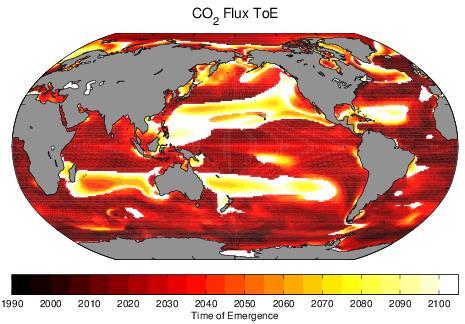Detection of anthropogenic ocean carbon sink emerges by mid-century
The ocean carbon sink is a cumulative net sink of anthropogenic carbon from the atmosphere, having absorbed 41% of all emissions due to fossil fuel and cement manufacturing. Going forward, this sink is expected to grow and to substantially mitigate atmospheric carbon accumulation. The rate at which the ocean carbon sink grows in response to the atmospheric CO2 perturbation, as well as the potential for it to be slowed by climate change feedbacks, is of critical interest. Over the last two decades, there is sufficient evidence to support the conclusion that the globally-integrated ocean carbon sink has grown in response to the growing atmospheric carbon content. However, uncertainty remains large, ~30% of the mean sink. In order to reduce this uncertainty and to better understand the mechanisms of the ocean carbon sink, a deeper, mechanistic understanding at regional scales is needed. Moreover, direct monitoring of the evolving sink will be continually necessary and will assist in verifying and improving future projections. A critical challenge to monitoring the evolving sink is the fact that the inherent variability of the climate system drives substantial variability in the ocean carbon sink. A new paper by McKinley et al. (2016) uses a large ensemble of the NCAR CESM climate model to directly assess the magnitude of internal variability in the ocean carbon sink and compare it to the magnitude of the forced trend. This allows estimation whengrowth of the sink could be detected from the noise of the variability (see Figure). Long-term data collection is essential for direct monitoring of this critical climate regulation service by the global oceans.

1University of Wisconsin-Madison
2NOAA Pacific Marine Environmental Laboratory
3National Center for Atmospheric Research
4University of Colorado
Topics
- Modeling
- Carbon
- Climate Change
